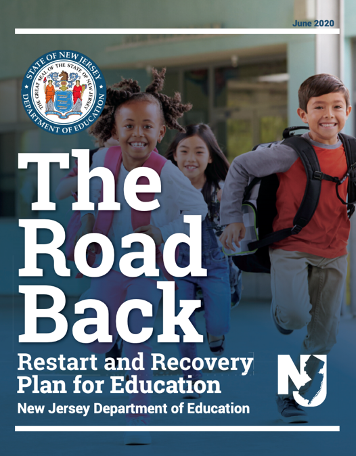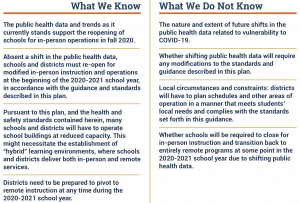On March 16, 2020, in an attempt to slow the spread of Covid-19 across the state, Governor Murphy issued an Executive Order that halted all in-person instruction in New Jersey’s schools. Widespread changes to our education system were implemented as educators, parents and community members mobilized to keep children learning to the best extent possible during these unprecedented times. Over the past several months, JerseyCAN has been active leader in these efforts, joining two statewide reopening committees, the New Jersey Department of Education (NJDOE)’s Restart and Recovery Committee and the Senate Education Recovery Task Force. On Friday, the NJDOE published its guidance, The Road Back: Restart and Recovery Plan for Education, a set of standards for reopening schools in Fall 2020. The following Q & A provides information for parents, educators, and education advocates to consider as they develop their plans to return to schools in the fall.
Will schools reopen in Fall 2020?
Yes. The guidance explicitly states that, “school buildings will open in some capacity for in-person instruction and operations in the Fall” (p. 6). At the same time, districts must be prepared to “adjust our educational models should the spread of the virus and consistent health data require it” (p. 6).
How are schools required to plan for reopening in Fall 2020?
Every district should establish a Restart Committee to work in collaboration with community stakeholders and support districts in developing a reopening plan that considers four key areas: conditions for learning, leadership and planning, leadership and planning, policy and funding, and continuity of learning. These areas include social, emotional and environmental factors, district and school-wide logistical and operational considerations, existing and pending federal and state legislation and regulations around funding, and the range of potential delivery models that will be dependent on the unique needs of individual districts.
What health and safety requirements are there?
The guidelines provide health and safety requirements for education within buildings and for transportation to and from school. While students are in school, districts should allow for social distancing within the classroom to the maximum extent practicable, for example, ensuring students are seated at least 6 feet apart, physical barriers between desks and turning desks to face the same directions. School staff and visitors are required to wear face coverings, and students are strongly encouraged to wear face coverings and are required to do so when not social distancing. Each school district must adopt cleaning/disinfecting procedures. Finally, school districts must adopt a policy for screening students and employees upon arrival for symptoms and history of exposure. When students are on buses to and from school, school districts are strongly encouraged to maintain social distancing, and where not feasible or prohibitively burdensome or expensive to maintain physical distancing, students must wear face coverings.
What will a school day look like?
The model for returning to school must include in-person learning, but could also include virtual learning, or a hybrid of both. A great deal of discretion is left up to districts to decide the capacity in which in-person instruction will continue in the fall, however, districts must “work closely with their stakeholders to ensure decisions are made collaboratively and transparently and prioritize safely returning students who are better suited with in-person instruction. This may include, but is not limited to, students with disabilities, English language learners (ELL), homeless youth, and low-income students” (p. 73).
Furthermore, districts are encouraged to provide a combination of synchronous and asynchronous instruction with several example models provided: 6-Day Rotations, A/B Weeks by Grade Band, and A/B Weeks Across Grades (see pages 51-52). Again, the guidance states that “as districts begin implementing in-person and hybrid learning models, they must also be prepared to shift back to virtual learning models if circumstances change and those guidelines can no longer be met” (p. 49).
How should schools approach teaching and learning?
Access to technology and connectivity is critical for learning in virtual and hybrid environments. First, districts should strive to ensure that every student has access to a device and internet connectivity, prioritizing the provision of technology, or, alternatively, in-person instruction, to students that are otherwise without access.
Furthermore, districts should anticipate “the high likelihood that many students made less than one full year of academic growth during the 2019-2020 school year” (p. 73). As a result, curriculum, instruction, and assessment should be designed to accelerate students’ progress during the upcoming years. Accelerated learning requires educators to utilize classroom time as efficiently as possible whether the mode of instruction be in-person, virtual or a hybrid of the two. Moreover, this means providing students with “grade-level materials, tasks, and assignments along with the appropriate supports necessary to fill the most critical gaps in learning” (p. 77).
Finally, educators should “focus on locally developed pre-assessments and formative assessments upon returning to school” (p. 80). Online pre-assessments and formative assessments should be leveraged in either a fully virtual or hybrid learning environment to support the evaluation of student strengths and areas for improvement, and to inform next steps, including determining whether remediation is required for an entire group of students or on an individual student basis.
Closing
The education system as we knew it changed on March 16, 2020, when Governor Murphy issued an Executive Order that halted all in-person instruction in New Jersey’s schools; now, schools are charged with developing return plans for the fall that meet their unique physical, organizational, fiscal, and student learning needs. The Road Back: Restart and Recovery Plan for Education is a set of standards published by the NJ Department of Education and provides guidelines for reopening schools in Fall 2020 around four key areas: conditions for learning, leadership and planning, leadership and planning, policy and funding, and continuity of learning. The model for returning to school must include in-person learning but could also include virtual learning, or a hybrid of both. School staff and visitors are required to wear face coverings, and students are strongly encouraged to wear face coverings and are required to do so when not social distancing. Along with ensuring that all students have access to devices and connectivity, districts must be thoughtful about curriculum, instruction, and assessment to anticipate learning loss and accelerate students’ progress during the upcoming years. This summer, districts will continue to work hard work as they form Restart Committees and collaborate with community members to plan their road back for Fall 2020.


